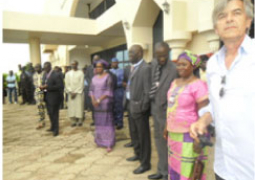
(Continuation)
Strategy
In most cases by the word "strategy" the planner mean merely the "official objective " of organization, but from our point of view and in accordance with the guidelines defined for formal and approved strategies in this text, there are certain characteristics for a practical strategy, as follows:
- It must be inclusive of a prelude, in which the keywords and concepts that are important in the strategy should be defined, and due to that prelude's significance, it should precede the other chapter:
- It should state the expectation of the organization:
- It should outline the official objectives:
- It should defined the perspectives:
- It should clarify the scene for materializing the activities of the organization:
- It should clarify the values and general executive policies in the process of a movement;
- It should mention the method and general means for achieving the objectives.
Midterm & long-term objectives:
This concept is inclusive of those goals that are often defined and stated for at lease a five year period. The main characteristic of such objectives is being more clear, and easier to be evaluated. That is because they are closer to achieve quantitative and real, with tangible statistics. Such objectives are meanwhile dynamic and dividable to short term, and even annul periods.
Short-term objectives
These objectives are derived from the above mentioned (long term) objectives, and the time span allocated to achieving them is usually a year.
Planning for annul periods:
In this phase the entire details of the plan, including its budget, and the staff allocated to its executive affairs, are one by one, defined clarified, and there are two distinctive phases for it:
In the phases allocated to moving from general point to the trivial point the clarity of the matter keeps increasing, and concrete and tangible issues get closer at hand.
The planer might proceed throughout these phases rapidly, and unknowingly, but in dealing with the details of each, as it is stated in old books of logic, the weak and problematic points of the plans are easily highlighted.
B: the Islamic model
If we intend to choose a model and paradigm from among the Islamic texts and regulation sets, we can for instance, single out the economic aspects of typical Islamic society. The mission put by such texts on the shoulders of the prophets, the leaders, and the pioneers, is the establishment of a justice-oriented society, through strengthening the foundation of social justice:
"We verily sent our messengers with proofs, and revealed with them the scriptures and the Balance, so that mankind might observe justice"
Therefore, the establishment of social justice is one of the objectives of the prophets. We can draw conclusion from this discussion that the official objectives, for sending divine messengers are manifested in two major fields namely: materializing cooperation and guaranteeing balance among life styles of the mankind. In the light of pursuing such objectives, it is possible to draw the outlines of the perspective in question in this way: "achieving a social status in which the entire efforts would be aimed at boosting production.
In the field of distribution, too, meeting the natural and urgent demands of the individuals and the establishment of a kind of balance in their lives is the objective of this span, based on which its perspective can be drawn.
Such a perspective would include of the entire required characteristics: it is both reflective of the official objectives, and easy to be recognized and defined, because it has real and tangible dimensions, and it is meanwhile in itself an attractive and attainable goal, which is both flexible and easy to be explained for the others.
In order to achieve such goals, too, certain policies need to be applied, including the following:
- Serious efforts aimed at directing the entire possibilities towards productive activities, and providing the scenes, the facilities, and the backgrounds for it, and for the nurturing of the required scientific competence for the purpose.
- Effort made to eliminate any type of extravagance, or over-prudence regarding the manpower capital, the kettles and other animals, and the other natural resources, and for instance, being benefited of an extraordinarily rich life style.
- Supporting the families, or the vulnerable and too poor individuals, in order to improve their living conditions to higher levels, through improving and strengthening the foundation of the public and social welfare services.
Islam has provided for the natural, legal, and jurisprudential facilities, based on which it is possible to devise the long term and short-term objectives and to draft the realistic five year, and then annual plans for the purpose.
C: Previous experience in devising strategies for proximity among Islamic schools
1. Experience of Daar-taqrib (proximity House)
Despite the existing ambiguities within this strategy, this pioneer effort was the harbinger of very precious results.
In the first communiqué, issued I volume one of Risalat-ulIslam (the prophecy of Islam) magazine with the signature of the head of Religious verdicts Issuance office at Al-Azhar University in Cairo, Allameh sheikh abdoul majid salim, there is a discussion over the foundations upon which proximity can be structured. Sheikh Salim has in that communiqué reiterated, "there is deference of opinion (among followers of various Islamic schools) over fixed rules of Islam, and the jurisprudence, is therefore effective in unfixed rules of dear Islam." That hypothesis is fully logical based o the teaching of our holy religion.
To be Continued


